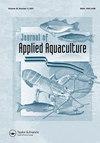高蛋白磷虾粉作为优化半集约条件下养殖的凡纳滨对虾幼鱼低成本配方的工具
IF 0.8
Q3 FISHERIES
引用次数: 1
摘要
摘要为了研究高蛋白磷虾粉(HPK)在低成本饲料中促进凡纳滨对虾(Litopenaeus vannamei)生长的潜力,本试验对商业对照和3%磷虾粉饲料进行了比较。为模拟半集约化养殖系统,在2.16 ha的池塘中,以25只/m2放养20笼,放养体重为3.07±0.01 g的对虾4500只。饲养60 d后,3% HPK饲粮的产量(22,094.0±130.35 g/笼)显著高于对照组饲粮(19,301.6±272.28 g/笼)(P < 0.05)。当比较每公斤对虾的饲料成本时,3% HPK组(1.01美元/公斤对虾)显著低于对照组(1.11美元/公斤对虾)。由此可见,在不增加配方成本的前提下,低成本饲料可以利用HPK部分替代鱼粉来优化对虾生长性能。本文章由计算机程序翻译,如有差异,请以英文原文为准。
High protein krill meal as a tool to optimize low cost formulas for juvenile Litopenaeus vannamei diets farmed under semi-intensive conditions
ABSTRACT To investigate the potential of high-protein krill meal (HPK) to improve growth in low-cost diets for Pacific white shrimp (Litopenaeus vannamei), a commercial control and a 3% HPK diet were compared. To simulate a semi-intensive culture system, a total of 4,500 shrimp with a body weight (BW) of 3.07 ± 0.01 g were stocked with 25 animals/m2 in 20 cages in a 2.16-ha pond. After 60 days of rearing, the 3% HPK diet achieved a significantly higher yield (22,094.0 ± 130.35 g/cage) in comparison to the control diet (19,301.6 ± 272.28 g/cage) (P < 0.05). When the feed cost per kg shrimp produced was compared, it was significantly lower in the 3% HPK group (US$1.01/kg shrimp) when compared to the control group (US$1.11/kg shrimp). The results indicate that low feeding cost diets can profit from the partial replacement of fish meal by HPK to optimize shrimp growth performance without increasing formula cost.
求助全文
通过发布文献求助,成功后即可免费获取论文全文。
去求助
来源期刊

Journal of Applied Aquaculture
Environmental Science-Ecology
CiteScore
3.20
自引率
0.00%
发文量
38
期刊介绍:
The Journal of Applied Aquaculture is a platform for the sharing of practical information needed by researchers to meet the needs of investors, farm managers, extension agents and policy makers working to adapt aquaculture theory to achieve economic and food security objectives in the real world. The journal emphasizes multi-disciplinary research and case studies that propose financially and logistically viable solutions to observable problems.
 求助内容:
求助内容: 应助结果提醒方式:
应助结果提醒方式:


